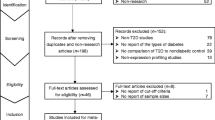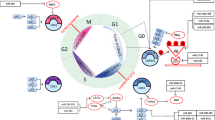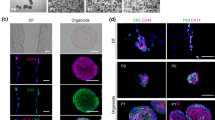Abstract
Ageing is among the main risk factors for human disease onset and the identification of the hallmarks of senescence remains a challenge for the development of appropriate therapeutic target in the elderly. Here, we compare senescence-related changes in two cell populations of mesenchymal stromal cells by analysing their miRNA profiling: Human Dental Pulp Stromal Cells (hDPSCs) and human Periosteum-Derived Progenitor Cells (hPDPCs). After these cells were harvested, total RNA extraction and whole genome miRNA profiling was performed, and DIANA-miRPath analysis was applied to find the target/pathways. Only 69 microRNAs showed a significant differential expression between dental pulp and periosteum progenitor cells. Among these, 24 were up regulated, and 45 were downregulated in hDPSCs compared to hPDPCs. Our attention was centered on miRNAs (22 upregulated and 34 downregulated) involved in common pathways for cell senescence (i.e. p53, mTOR pathways), autophagy (i.e. mTOR and MAPK pathways) and cell cycle (i.e. MAPK pathway). The p53, mTOR and MAPK signaling pathways comprised 43, 37 and 112 genes targeted by all selected miRNAs, respectively. Our finding is consistent with the idea that the embryological origin influences cell behavior and the ageing process. Our study strengthens the hypothesis that ageing is driven by numerous mediators interacting through an intricate molecular network, which affects adult stem cells self-renewal capability.

Graphical abstract





Similar content being viewed by others
References
López-Otín, C., Blasco, M. A., Partridge, L., Serrano, M., & Kroemer, G. (2013). The hallmarks of aging. Cell, 153(6), 1194–1217. https://doi.org/10.1016/j.cell.2013.05.039.
Niccoli, T., & Partridge, L. (2012). Ageing as a risk factor for disease. Current Biology, 22(17), R741–R752. https://doi.org/10.1016/j.cub.2012.07.024.
Sperka, T., Wang, J., & Rudolph, K. (2012). DNA damage checkpoints in stem cells, ageing and Cancer. Nature Reviews Molecular Cell Biology, 13(9), 579–590. https://doi.org/10.1038/nrm3420.
Boyette, L. B., & Tuan, R. S. (2014). Adult stem cells and diseases of aging. Journal of Clinical Medicine, 3(1), 88–134. https://doi.org/10.3390/jcm3010088.
Jones, D. L., & Rando, T. A. (2011). Emerging models and paradigms for stem cell ageing. Nature Cell Biology, 13(5), 506–512. https://doi.org/10.1038/ncb0511-506.
Oh, J., Lee, Y., & Wagers, A. (2014). Stem cell aging: Mechanisms, regulators and therapeutic opportunities. Nature Medicine, 20(8), 870–880. https://doi.org/10.1038/nm.3651.
Kuilman, T., Michaloglou, C., Mooi, W. J., & Peeper Daniel, S. (2010). The essence of senescence. Genes & Development, 24(22), 2463–2479. https://doi.org/10.1101/gad.1971610.
Kurz, D. J., Decary, S., Hong, Y., & Erusalimsky, J. D. (2000). Senescence-associated (Beta)-Galactosidase reflects an increase in Lysosomal mass during replicative ageing of human endothelial cells. Journal of Cell Science, 113(20), 3613–3622.
Jiang, H., Ju, Z., & Rudolph, K. L. (2007). Telomere Shortening and Ageing. Zeitschrift Fur Gerontologie Und Geriatrie, 40(5), 314–324. https://doi.org/10.1007/s00391-007-0480-0.
Papadopoulos, G. L., Alexiou, P., Maragkakis, M., Reczko, M., & Hatzigeorgiou, A. G. (2009). DIANA-MirPath: Integrating human and mouse MicroRNAs in pathways. Bioinformatics (Oxford, England), 25(15), 1991–1993. https://doi.org/10.1093/bioinformatics/btp299.
Rufini, A., Tucci, P., Celardo, I., & Melino, G. (2013). Senescence and aging: The critical roles of P53. Oncogene, 32(43), 5129–5143. https://doi.org/10.1038/onc.2012.640.
Yang, Z., & Klionsky, D. J. (2010). Eaten alive: A history of macroautophagy. Nature Cell Biology, 12(9), 814–822. https://doi.org/10.1038/ncb0910-814.
Papadopoli, D., Boulay, K., Kazak, L., Pollak, M., Mallette, F., Topisirovic, I., & Hulea, L. (2019). MTOR as a Central Regulator of Lifespan and Aging. F1000Research 8 (July). https://doi.org/10.12688/f1000research.17196.1.
He, Y., She, H., Zhang, T., Xu, H., Cheng, L., Yepes, M., Zhao, Y., & Mao, Z. (2018). P38 MAPK inhibits autophagy and promotes microglial inflammatory responses by phosphorylating ULK1. The Journal of Cell Biology, 217(1), 315–328. https://doi.org/10.1083/jcb.201701049.
Zhou, Y, Y., Li, Y., Jiang, W, Q., & Zhou, L, F. (2015). MAPK/JNK Signalling: A potential autophagy regulation pathway. Bioscience Reports 35 (3). https://doi.org/10.1042/BSR20140141.
Xia, X., Chen, W., McDermott, J. & Han, J, D, J. 2017. Molecular and Phenotypic Biomarkers of Aging. F1000Research 6 (June). https://doi.org/10.12688/f1000research.10692.1.
Dodig, S., Čepelak, I. & Pavić, I. (2019). Hallmarks of senescence and aging. Biochemia Medica 29 (3). https://doi.org/10.11613/BM.2019.030501.
Kumar, S., Vijayan, M., Bhatti, J, S., & Reddy, P, H. (2017). Chapter three - MicroRNAs as peripheral biomarkers in aging and age-related diseases. In Progress in Molecular Biology and Translational Science, edited by P. Hemachandra Reddy, 146:47–94. Molecular biology of aging. Academic press. https://doi.org/10.1016/bs.pmbts.2016.12.013.
Bartel, D. P. (2018). Metazoan MicroRNAs. Cell, 173(1), 20–51. https://doi.org/10.1016/j.cell.2018.03.006.
Shenoy, A., & Blelloch, R, H. 2014. Regulation of MicroRNA function in somatic stem cell proliferation and differentiation. Nature Reviews. Molecular Cell Biology 15 (9): 565–76. https://doi.org/10.1038/nrm3854.
Maes, O. C., An, J., Sarojini, H., & Wang, E. (2008). Murine MicroRNAs implicated in liver functions and aging process. Mechanisms of Ageing and Development, 129(9), 534–541. https://doi.org/10.1016/j.mad.2008.05.004.
Li, N., Bates, D. J., An, J., Terry, D. A., & Wang, E. (2011). Up-regulation of key MicroRNAs, and inverse down-regulation of their predicted oxidative phosphorylation target genes, during aging in mouse brain. Neurobiology of Aging, 32(5), 944–955. https://doi.org/10.1016/j.neurobiolaging.2009.04.020.
Gu, S., Ran, S., Liu, B., & Liang, J. (2016). MiR-152 induces human dental pulp stem cell senescence by inhibiting SIRT7 expression. FEBS Letters, 590(8), 1123–1131. https://doi.org/10.1002/1873-3468.12138.
Vozzi, G., Lucarini, G., Dicarlo, M., Andreoni, C., Salvolini, E., Ferretti, C., & Mattioli-Belmonte, M. (2016). In vitro lifespan and senescent behaviour of human periosteal derived stem cells. Bone, 88(July), 1–12. https://doi.org/10.1016/j.bone.2016.04.013.
Dicarlo, M., Teti, G., Iezzi, I., Cerqueni, G., Manzotti, S., Falconi, M., & Mattioli-Belmonte, M. (2018). Detecting senescent fate in Mesenchymal stem cells: A combined Cytofluorimetric and Ultrastructural approach. Biogerontology, 19(5), 401–414. https://doi.org/10.1007/s10522-018-9766-4.
Iezzi, I., Cerqueni, G., Licini, C., Lucarini, G., & Mattioli, B. M. (2019). Dental pulp stem cells senescence and regenerative potential relationship. Journal of Cellular Physiology, 234(5), 7186–7197. https://doi.org/10.1002/jcp.27472.
Mahajan, A. (2012). Periosteum: A Highly Underrated Tool in Dentistry. International Journal of Dental, 2012, 717816–717816. https://doi.org/10.1155/2012/717816.
Mosquera-Perez, R., Fernández-Olavarria, A., Diaz-Sanchez, R. M., Gutierrez-Perez, J. L., Serrera-Figallo, M. Á., & Torres-Lagares, D. (2019). Stem cells and oral surgery: A systematic review. Journal of Clinical and Experimental Dentistry, 11(12), e1181–e1189. https://doi.org/10.4317/jced.56571.
Tatullo, M., Marrelli, M., & Paduano, F. (2015). The regenerative medicine in Oral and maxillofacial surgery: The Most important innovations in the clinical application of Mesenchymal stem cells. International Journal of Medical Sciences, 12(1), 72–77. https://doi.org/10.7150/ijms.10706.
Gronthos, S., Brahim, J., Li, W., Fisher, L. W., Cherman, N., Boyde, A., DenBesten, P., Gehron Robey, P., & Shi, S. (2002). Stem cell properties of human dental pulp stem cells. Journal of Dental Research, 81(8), 531–535. https://doi.org/10.1177/154405910208100806.
Ferretti, C., Borsari, V., Falconi, M., Gigante, A., Lazzarini, R., Fini, M., Di Primio, R., & Mattioli-Belmonte, M. (2012). Human Periosteum-derived stem cells for tissue engineering applications: The role of VEGF. Stem Cell Reviews and Reports, 8(may), 882–890. https://doi.org/10.1007/s12015-012-9374-7.
Dominici, M., Le Blanc, K., Mueller, I., Slaper-Cortenbach, I., Marini, F., Krause, D., et al. (2006). Minimal criteria for defining multipotent Mesenchymal stromal cells. The International Society for Cellular Therapy Position Statement. Cytotherapy, 8(4), 315–317. https://doi.org/10.1080/14653240600855905.
Lewis, B. P., Burge, C. B., & Bartel, D. P. (2005). Conserved seed pairing, often flanked by adenosines, indicates that thousands of human genes are MicroRNA targets. Cell, 120, 15–20.
Harries, L. (2014). MicroRNAs as mediators of the ageing process. Genes, 5(3), 656–670. https://doi.org/10.3390/genes5030656.
Ferretti, C., Lucarini, G., Andreoni, C., Salvolini, E., Bianchi, N., Vozzi, G., Gigante, A., & Mattioli-Belmonte, M. (2015). Human periosteal derived stem cell potential: The impact of age. Stem Cell Reviews and Reports, 11(3), 487–500. https://doi.org/10.1007/s12015-014-9559-3.
Ito, K., Yamada, Y., Nakamura, S., & Ueda, M. (2011). Osteogenic potential of effective bone engineering using dental pulp stem cells, bone marrow stem cells, and periosteal cells for Osseointegration of dental implants. The International Journal of Oral & Maxillofacial Implants, 26(5), 947–954.
Ichikawa, Y., Watahiki, J., Nampo, T., Nose, K., Yamamoto, G., Irie, T., Mishima, K., & Maki, K. (2015). Differences in the developmental origins of the Periosteum may influence bone healing. Journal of Periodontal Research, 50(4), 468–478. https://doi.org/10.1111/jre.12229.
Orciani, M., Di Primio, R., Ferretti, C., Orsini, G., Salvolini, E., Lazzarini, R., & Mattioli-Belmonte, M. (2012). In vitro evaluation of Mesenchymal stem cell isolation possibility from different intra-Oral tissues. Journal of Biological Regulators and Homeostatic Agents, 26(2 Suppl), 57–63.
Ledesma-Martínez, E., Mendoza-Núñez, V, M., & Santiago-Osorio, E. (2016). Mesenchymal Stem Cells Derived from Dental Pulp: A Review. Stem Cells International 2016. https://doi.org/10.1155/2016/4709572.
Duchamp de Lageneste, O., Julien, A., Abou-Khalil, R., Frangi, G., Carvalho, C., Cagnard, N., Cordier, C., Conway, S. J., & Colnot, C. (2018). Periosteum Contains Skeletal Stem Cells with High Bone Regenerative Potential Controlled by Periostin. Nature Communications, 9(1), 773. https://doi.org/10.1038/s41467-018-03124-z.
Matheu, A., Maraver, A., & Serrano, M. (2008). The Arf/P53 pathway in Cancer and aging. Cancer Research, 68(15), 6031–6034. https://doi.org/10.1158/0008-5472.CAN-07-6851.
Vaseva, A, V., & Moll, U, M. (2009). “The Mitochondrial P53 Pathway.” Biochimica et Biophysica Acta (BBA) - Bioenergetics, Mitochondrial Physiology and Pathology, 1787 (5): 414–20. https://doi.org/10.1016/j.bbabio.2008.10.005
Zhang, D, Y., Wang, H, J., & Tan, Y, Z. (2011). Wnt/β-Catenin Signaling Induces the Aging of Mesenchymal Stem Cells through the DNA Damage Response and the P53/P21 Pathway. PLoS ONE 6 (6). https://doi.org/10.1371/journal.pone.0021397.
Baker, D. J., Childs, B. G., Durik, M., Wijers, M. E., Sieben, C. J., Zhong, J., et al. (2016). Naturally Occurring P16 Ink4a -Positive Cells Shorten Healthy Lifespan. Nature, 530(7589), 184–189. https://doi.org/10.1038/nature16932.
Freund, A., Patil, C. K., & Campisi, J. (2011). P38MAPK Is a Novel DNA Damage Response-Independent Regulator of the Senescence-Associated Secretory Phenotype. The EMBO Journal, 30(8), 1536–1548. https://doi.org/10.1038/emboj.2011.69.
Passos, J. F., Nelson, G., Wang, C., Richter, T., Simillion, C., Proctor, C. J., Miwa, S., et al. (2010). Feedback between P21 and Reactive Oxygen Production Is Necessary for Cell Senescence. Molecular Systems Biology, 6, 347. https://doi.org/10.1038/msb.2010.5.
Zhang, J. H., Zhang, Y., & Herman, B. (2003). Caspases, Apoptosis and Aging. Ageing Research Reviews, 2(4), 357–366. https://doi.org/10.1016/S1568-1637(03)00026-6.
Hill, C. G., Matyunina, L. V., Walker, D., Benigno, B. B., & MscDonald, J. F. (2014). Transcriptional override: A regulatory network model of indirect responses to modulations in MicroRNA expression. BMC Systems Biology, 8(March), 36. https://doi.org/10.1186/1752-0509-8-36.
Lin, J., & Amir A. (2018). “Homeostasis of Protein and MRNA Concentrations in Growing Cells.” Nat. Commun. 9 (1). https://doi.org/10.1038/s41467-018-06714-z.
Barbosa, M.,. C., Grosso, R.,. A., & Fader, C.,. M. (2019). Hallmarks of aging: An Autophagic perspective. Frontiers in Endocrinology, 9(January). https://doi.org/10.3389/fendo.2018.00790.
Bergamini, E., Cavallini, G., Donati, A., & Gori, Z. (2004). The role of macroautophagy in the ageing process, anti-ageing intervention and age-associated diseases. The International Journal of Biochemistry & Cell Biology, Autophagy and Cell Fate, 36(12), 2392–2404. https://doi.org/10.1016/j.biocel.2004.05.007.
Rodier, F., Campisi, J., & Bhaumik, D. (2007). Two faces of P53: Aging and tumor suppression. Nucleic Acids Research, 35(22), 7475–7484. https://doi.org/10.1093/nar/gkm744.
Alraies, A., Alaidaroos, N. Y. A., Waddington, R. J., Moseley, R., & Sloan, A. J. (2017). Variation in human dental pulp stem cell ageing profiles reflect contrasting proliferative and regenerative capabilities. BMC Cell Biology, 18, 12. https://doi.org/10.1186/s12860-017-0128-x.
Author information
Authors and Affiliations
Corresponding author
Ethics declarations
Conflict of Interest
The authors did not receive support from any organization for the submitted work.
Ethical Approval
The study was following the Marche region Ethics Board guidelines and with the 1964 Declaration of Helsinki and its later amendments. All subjects were aware that the tissue was discarded surgical material and the study did not expose them to any risk. A verbal informed consent and was obtained in lieu of a written authorization.
Additional information
Publisher’s Note
Springer Nature remains neutral with regard to jurisdictional claims in published maps and institutional affiliations.
Rights and permissions
About this article
Cite this article
Iezzi, I., Lazzarini, R., Cerqueni, G. et al. MicroRNA Profiling in Mesenchymal Stromal Cells: the Tissue Source as the Missing Piece in the Puzzle of Ageing. Stem Cell Rev and Rep 17, 1014–1026 (2021). https://doi.org/10.1007/s12015-020-10095-6
Accepted:
Published:
Issue Date:
DOI: https://doi.org/10.1007/s12015-020-10095-6




